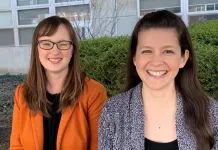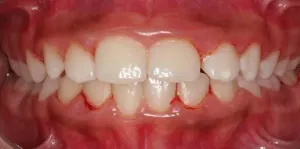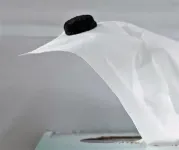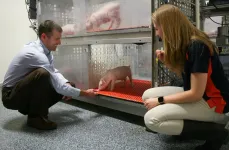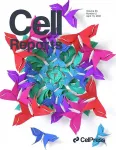(Press-News.org) URBANA, Ill. - Food waste and obesity are major problems in developed countries. They are both caused by an overabundance of food, but strategies to reduce one can inadvertently increase the other. A broader perspective can help identify ways to limit food waste while also promoting healthy nutrition, two University of Illinois researchers suggest.
"You can reduce food waste by obtaining less or eating more. Our concern was that if people are reducing waste by eating more, what does that mean for nutrition? And how do we think about these tradeoffs in a way that promotes both good nutrition outcomes and good food waste outcomes? Public policies have generally focused on either obesity or food waste, but rarely considered them together, says Brenna Ellison, associate professor in the Department of Agricultural and Consumer Economics (ACE) at U of I.
Ellison and Melissa Pflugh Prescott, assistant professor in the Department of Food Science and Human Nutrition (FSHN) at U of I, discuss a systems approach to addressing food waste and nutrition in a new paper, published in Journal of Nutrition Education and Behavior.
Food waste refers to the loss of edible food that is not consumed for various reasons. It occurs at all levels of the supply chain, from farm to transportation, processing, retail, food service, and consumer levels.
Food waste is often calculated by weight or by calories, Ellison explains. If you calculate by weight, dairy products, vegetables, grain products, and fruit account for the majority of food loss. But when converted to calories, added fats and oils, grain products, and added sugars and sweeteners are the top categories for food waste. Encouraging increased consumption of those foods could have negative health consequences, she notes.
In their paper, Ellison and Prescott provide strategies for reducing food waste in a variety of settings, including food service, retail, schools, and homes.
Some restaurants and university dining halls that offer buffet-style dining have tried to limit food waste by imposing fines or offering incentives to ensure people finish the food they select. While such strategies may limit waste, they encourage overeating, the researchers say. They suggest instead using behavioral cues such as smaller plates and scoops that nudge people to select less food.
School meals are important means to improve public health and introduce children to new, healthy foods. However, plate waste is a persistent problem in school lunch settings. Schools can use salad bars to encourage students to try new items, but that causes pre-plate waste because some items are not selected. COVID-19 modifications pose additional challenges to safe strategies for food recovery, but there are still viable options, Prescott states.
"For example, schools can take items like whole apples or unopened cartons of milk and recycle them. They can reuse them in future meals, making sure they are following food safety protocols. Or they can donate them to food pantries and other nonprofit organizations, or create backpack programs where they can send some of those items home with students who may be struggling with food insecurity. There are certainly ways to do this safely," she says.
The researchers note that households are responsible for some of the costliest food waste, because they are at the end of the supply chain. Consumers throw away food for various reasons, such as food safety concerns, desire to eat fresh food, and poor food management.
Choosing more processed food could reduce waste but is not desirable from a health perspective. Learning strategies for better meal planning and using a list for grocery shopping are better ways to accomplish both waste reduction and improved nutrition goals, Ellison says.
"We know that even if you try to plan meals, it can be hard to follow through. It's important to be realistic about planning. For example, if you know that you're likely to order take out one or two nights a week, then plan for that. Don't buy food you won't need," she notes.
The researchers also suggest ways to encourage good nutrition through small changes. "If you have young kids, you can try frozen vegetables. You can take a little bit out at a time and do some testing with your children; you won't have a whole package that might go to waste," Ellison says.
Better cooking skills are also important, Prescott states.
"Cooking is a win-win in terms of promoting health and reducing food waste. There is evidence that links cooking and improved diet quality. And people who cook might over time become more skilled at repurposing leftovers, and being more creative with foods that are about to go to waste," she says. "Freezing leftovers for future meals is also a helpful strategy, if you have freezer space."
Prescott notes that some of these strategies may be difficult for families that lack adequate equipment for cooking, storing, and freezing. She and Ellison are working to develop a cooking education curriculum primarily addressing the challenges facing low-income households who may have limited resources available.
The two researchers are also planning a study on school nutrition aiming to identify behavioral nudges to increase fruit and vegetable consumption while reducing waste, and a project focusing on safety issues of food recovery in schools.
Illinois Extension provides information and resources for families wanting to learn more about nutrition and wellness.
INFORMATION:
Ellison and Prescott discuss their research and strategies for obesity prevention and food waste reduction in a podcast, available at the U of I Center for the Economics of Sustainability website.
The Department of Agricultural and Consumer Economics and the Department of Food Science and Human Nutrition are in the College of Agricultural, Consumer and Environmental Sciences, University of Illinois.
The paper, "Examining nutrition and food waste trade-offs using an obesity prevention context," is published in Journal of Nutrition Education and Behavior. [https://doi.org/10.1016/j.jneb.2020.11.005]
Authors include Brenna Ellison and Melissa Pflugh Prescott.
By Luciana Constantino | Agência FAPESP – Adults with periodontitis transmit bacteria that can cause the disease in future to their children, and the bacteria remain in the oral cavity even when the children undergo treatment of various kinds, reinforcing the need for preventive care in the first year of a baby’s life. This is the main conclusion of a study conducted at the University of Campinas (UNICAMP) in the state of São Paulo, Brazil. An article on the study is published in Scientific Reports.
Periodontitis is an inflammation of the periodontium, the tissue that supports the teeth and maintains them in the maxillary and mandibular bones. The disease is triggered by bacterial infection. Symptoms include bleeding of the gums and halitosis. In severe cases, it ...
BUFFALO, N.Y. -- Graphene excels at removing contaminants from water, but it's not yet a commercially viable use of the wonder material.
That could be changing.
In a recent study, University at Buffalo engineers report a new process of 3D printing graphene aerogels that they say overcomes two key hurdles -- scalability and creating a version of the material that's stable enough for repeated use -- for water treatment.
"The goal is to safely remove contaminants from water without releasing any problematic chemical residue," says study co-author Nirupam Aich, PhD, assistant professor of environmental engineering at the UB School of Engineering and Applied Sciences. "The aerogels ...
HERSHEY, Pa. -- People who trust television and Facebook to provide them with accurate news about the coronavirus pandemic are less knowledgeable about COVID-19, according to a new study, which assessed people's knowledge of the virus in the earliest stages of the pandemic.
The study, published in the peer-reviewed journal Current Medical Research & Opinion, surveyed 5,948 adults in Pennsylvania between March 25-31, 2020, and found that those who relied on social media and TV for news were less likely to get the facts right about the coronavirus.
In fact, adults that used Facebook as an additional ...
URBANA, Ill. - Before humans can benefit from new drug therapies and nutritional additives, scientists test their safety and efficacy in animals, typically mice and rats. But, as much as they've done for biomedical research, rodents aren't always the best research model for studies on neonatal brain development and nutrition. That's where pigs can play an important role.
University of Illinois researchers say the domestic pig is ideal for these studies because their brain size, rate of development, and digestive system are excellent analogues for human newborns.
They know a lot about pig brains, having built the first - and recently, the second - complete, MRI-based atlases of the organ. They've used the first to study ...
La Jolla, CA--The human genome contains the instructions to make tens of thousands of proteins. Each protein folds into a precise shape--and biologists are taught that defined shape dictates the protein's destined function. Tens of thousands of singular shapes drive the tens of thousands of needed functions.
In a new Cell Reports study, researchers at La Jolla Institute for Immunology demonstrate how Ebola virus has found a different way to get things done. The virus encodes only eight proteins but requires dozens of functions in its lifecycle. ...
New research by a team at Resources for the Future (RFF) has found that at least 27% of new pests in the United States were initially detected by members of the general public. The study, which was published today in the journal Conservation Science and Practice, seeks to understand who is identifying new invasive species that make their way into the United States.
The RFF team developed and analyzed a new dataset of pest discoveries in the United States, using a sample size of 169 detections from 2010 to 2018. Researchers divided discovery sources into three categories: government agencies, local extension specialists and researchers, and members of the public, with the latter category including community ...
ITHACA, N.Y. - Just as humans are challenged from the social isolation caused by the coronavirus pandemic, a new study finds that a solitary lifestyle has profound effects on the brains of a social insect: paper wasps.
Paper wasps recognize the brightly colored faces of other paper wasps, an ability they lose when reared in isolation. The wasps' ability to remember faces is similar to primates and humans, but unlike other social insects.
The study revealed that when adult wasps are housed in solitude, visual areas of their brains - especially those involved with identifying nuanced color patterns and shapes - are smaller and less developed ...
Researchers from the HSE Center for Language and Brain https://www.hse.ru/en/neuroling/ have, for the first time, described the language abilities of Russian children with Autism Spectrum Disorder (ASD) at all linguistic levels (e.g., phonology, lexicon, morphosyntax, and discourse), using a language test that takes into account the psycholinguistic variables most relevant for Russians. The study was published in Journal of Autism and Developmental Disorders.
In 2020, the US Centers for Disease Control and Prevention reported that one in every 54 children in the country is diagnosed with ASD. Usually, ...
Ultralight bosons are hypothetical particles whose mass is predicted to be less than a billionth the mass of an electron. They interact relatively little with their surroundings and have thus far eluded searches to confirm their existence. If they exist, ultralight bosons such as axions would likely be a form of dark matter, the mysterious, invisible stuff that makes up 85 percent of the matter in the universe.
Now, physicists at MIT's LIGO Laboratory have searched for ultralight bosons using black holes -- objects that are mind-bending orders of magnitude ...
Little is known about azhdarchid pterosaurs, gigantic flying reptiles with impressive wingspans of up to 12 meters. Cousins of dinosaurs and the largest animals ever to fly, they first appeared in the fossil record in the Late Triassic about 225 million years ago and disappeared again at the end of the Cretaceous period about 66 million years ago. One of their most notable features for such a large flighted animal was a neck longer than that of a giraffe. Now, researchers report an unexpected discovery in the journal iScience on April 14: their thin neck vertebrae got their strength from an intricate internal structure unlike anything ...
